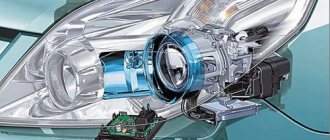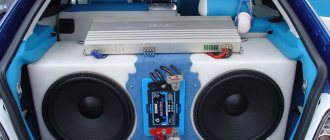Every driver must know the meaning of all road signs and markings. There are many outwardly similar signs that have different meanings. A striking example is the “No Stopping” and “No Parking” signs. Despite the obvious similarity, which can be traced even in the name, they have different meanings.
Indication “Stopping prohibited” 3.2.7 is a circle inside with two crossed lines
The punishment for violating the standards that they establish on a specific section of the road will also differ. Particular attention should be paid to the sign prohibiting stopping, since it is usually installed on busy highways, where any hitch can lead to an accident.
The difference between “stopping” a car and “parking”
Before understanding all the nuances associated with sign 3.27, it is important to learn to distinguish between the terms “stop” and “parking”. Despite the significant difference in these concepts, inexperienced drivers quite often confuse them or even consider them synonymous.
The difference in concepts is important to take into account when interpreting signs 3.27 and 3.28, prohibiting stopping and parking, respectively
And as you know, ignorance of the terms that appear in the law leads to emergency situations that often end in failure.
A stop is a situation when the driver stops driving for a short time in order to load/unload the car with things or drop off passengers.
If the period when the car is not moving has been prolonged and lasts more than 5 minutes, then this is already considered parking, regardless of whether the driver is in the car or not.
Thus, parking can be equated to parking due to the similar meaning of the terms. If the first strictly prohibits stopping, then the second allows you to stop moving for a short period of time.
The location of the sign is the beginning of the section where there is a prohibition on stopping
Therefore, while under the 3.28 shield, you can slow down briefly to let a passenger in/out, or empty the trunk of things.
It is important to understand that no road sign is installed “for show,” and sign 3.27 is no exception. Ignoring it on a busy highway can lead not only to traffic jams, but also to an accident.
Validity area of the traffic rules sign “No stopping”
Sign 3.27 imposes a taboo on stopping vehicles in its coverage area. The sign looks like a blue circular shield with a red border and similar colored lines that intersect to form the Latin letter “X”.
Signs can indicate the beginning of a particular settlement or its end
Sometimes the sign can be supplemented with marking 1.4, which is a yellow solid line at the edge of the road, limiting the effect of the sign to its end. In its absence, the ban applies until the first intersection or the end of a populated area, depending on which landmark you encounter on the way first.
Important! The ban applies only to that part of the road on the side of which the sign is installed.
How many minutes can you stand under the sign?
Road sign 3.27 imposes an absolute ban on stopping traffic in its coverage area. This means that you cannot stop at all under the shield, and even a fleeting pause in movement will be regarded as an illegal action.
An exception to the rules are cases when the driver made a forced brake due to a vehicle malfunction or poor health. Such factors make it possible to resort to an emergency stop even under a prohibitory sign.
Additional signs with arrows
A shield that prohibits stopping movement can be supplemented with additional signs that affect its coverage area. Thus, an additional sign with an image of an up arrow should be regarded as a signal that the restriction has come into force, and it will be impossible to stop after the sign.
If there are also numbers next to the arrow, then they indicate the range of the indicator in meters (8.2.1 and 8.2.2). A driver who sees a sign with two arrows facing in opposite directions (sign 8.2.4) can be sure that he continues to be in the prohibited zone.
A sign with a down arrow (8.2.3) indicates that the limiter has expired and you can stop. Signs with arrows pointing to the sides help the driver determine the prohibited area. These include signs 8.3.1-8.3.3.
Validity of the sign on even and odd days
Often on the roads you can see a “no parking” sign, which is supplemented by one or two vertical lines. These stripes indicate that the sign is valid for a limited time. Thus, a sign with one line prohibits parking on odd days, and a sign with two lines prohibits parking on even days.
Designation of prohibitory signs that operate only on even or odd days
Such temporary restrictions apply only to sign 3.28, which prohibits long-term parking of a car, and not a short stop. And the sign that imposes a taboo even on stopping traffic for a minute is valid every day, regardless of the date, which is important for every driver to take into account.
Road traffic signs permitting parking
First you need to understand that a stop sign and a parking sign are two completely different signs. The main difference occurs in duration:
- Stopping is a short-term maneuver that takes a few minutes;
- parking is a long maneuver and assumes that the car will occupy a certain area for a long time.
Traffic rules tell us that a stop is a deliberate cessation of movement of a vehicle, the duration of which does not exceed 5 minutes, while parking is a cessation of movement for more than 5 minutes, for reasons that are not related to loading, unloading, transfer and so on.
Parking, as well as stopping, is carried out in strictly defined places. The parking sign is number 6.4. This is the English letter "P" on a blue background.
Sign 6.4 parking or parking space (synonyms: “parking permitted” or “road sign P”) extends its coverage to the nearest intersection. However, if the action applies only to a specific zone, the footage must also be indicated.
If parking is provided near any shopping center, with mandatory entry into a pocket, then there should be a sign under the sign that indicates the way in which the car should be left.
When it comes to parking for a person with disabilities, plate 6.4 and special markings are used under the symbol. So, if you yourself have equipped a parking space for the disabled, it is worth considering that it should be slightly wider than the space you are used to and be already 3.5 m.
To make it easier to park a vehicle in places where long-term parking is allowed, it is better to apply special markings that would show the driver exactly how the car should be parked so as not to disturb others.
More on AutoLex.Net:
Symbol 4.1.1, or the sign “Move straight ahead”: features of the passage that the sign prohibits
Sign 6.4 - “Parking (parking space)”
Unfortunately, such markings are often not visible on Russian roads; they are erased and drowned in puddles or snow. This is why various traffic accidents occur or the driver is fined for incorrectly positioning the vehicle.
Despite the fact that there is a sign that allows parking, it is still necessary to simultaneously analyze the situation around:
- How much do you disturb other travelers;
- Are you blocking entry to the territory of any institutions?
Only if you are sure that all the nuances have been followed, you can leave the car and go about your business.
Exceptions to the rules in 2021
There is an opinion that only a prohibitory sign has the same significance for all Russian drivers, but this is far from the case.
Route transport has the right to stop in areas where restrictions apply
In addition to drivers who are forced to make an emergency stop due to health problems or vehicle malfunctions, sign 3.27 can be ignored by disabled people of groups 1 and 2 who have a badge on their car confirming their status (but only if there is an additional sign 8.18 “Except for disabled people” under the sign itself ), as well as drivers:
- minibuses and other types of public transport, subject to the availability of an equipped stop in the sign area;
- cars representing the postal service;
- vehicles stopped by traffic police officers;
- taxi with the taximeter turned on.
If the reason for the stop was poor health or a vehicle malfunction, it is important to inform other road users about the fact of emergency braking. To do this, it is necessary to turn on the alarm signal and, if possible, install an appropriate indicator.
In all other situations, a citizen driving a vehicle must stop only in places permitted for this, regardless of the length of the period of inactivity.
We also remind you that new fines for expired licenses have come into effect in 2021.
Which ones prohibit parking?
Sign 3.28 “no parking” is somewhat similar to the one that prohibits stopping. The prohibiting element looks like a blue circle with a red border and a red diagonal in the center.
The ban applies to absolutely all vehicles. However, an exception is made for vehicles that:
- Stopped for no more than 5 minutes to load or unload;
- board or disembark passengers.
The effect of the sign extends only to that side of the road where the sign is actually located.
The action is canceled by the next intersection or cancellation sign.
At the same time, the ban may be accompanied by road markings in the form of a yellow broken line 1.10. As a rule, it is applied to the edge of the roadway, that is, to the curb. Therefore, in winter it may not be noticeable.
Sign 3.28 - “Parking prohibited”
Exceptions are made for vehicles:
- Which provide assistance to the postal service;
- vehicles for disabled people of groups 1 and 2;
- taxis with the taximeter turned on;
- vehicles of persons transporting disabled children.
The sign is installed in places where parking is prohibited due to the fact that if the car stops, it will interfere with other vehicles or block the work of any institutions.
The sign can be valid until:
- The beginning of the settlement;
- its end;
- to sign 3.31, which symbolizes the end of all restrictions.
Also, footage can be set, which indicates the distance over which the action extends.
At the same time, the sign can be combined with other signs.
- For example, 3.28, together with plate 8.4.1 or 8.4.8, indicates the specific type of vehicle that is affected by the ban. The rest have the right to leave their vehicle.
- Double-sided arrow 8.2.4 means that you are currently within the coverage area of this sign in both directions.
- Combination with plate 8.2.3 means that the sign’s coverage area has ended.
More on AutoLex.Net:
Basic traffic rules: driving in lanes, signs and restrictions, three-lane rules
Fines for illegal stopping and parking
Ignoring prohibition signs can not only provoke a dangerous situation on the road, but also significantly “hit” the violator’s pocket. Thus, if at least one rule is not followed, it is unlikely that you will be able to avoid a “chain letter”.
If a car under a prohibitory sign is obstructing traffic, it will be towed
For stopping under sign 3.27, the violator faces a financial penalty in the amount of 500 to 5,000 rubles, depending on the severity of the offense. In this case, the maximum fine will be received by a driver who parked in a space for disabled people, but is not one.
For parking under a prohibiting sign, you can get away with 500 rubles, provided that the driver’s actions did not interfere with adequate traffic.
Important! In Moscow and St. Petersburg, the fine for parking in the wrong place is 1.5 or 3 thousand rubles. The amount of the penalty depends on how much the offender’s actions interfered with the movement of other vehicles or pedestrians. This difference in punishment is due to the fact that cities have federal status.
Preventive measures for parking in the wrong place are prescribed in Art. 12.19 of the Code of Administrative Offenses of the Russian Federation and its actions apply to all regions of the country, with the exception of cities of federal significance. Thus, parking in tunnels or in places that impede traffic will cost the driver 2,000 rubles.
For braking at or near a pedestrian crossing you will have to pay 1000 rubles
A similar amount will need to be paid to the state for stopping traffic in a place intended for stopping public transport or taxis, as well as at a distance of 15 m from it. Those who leave their cars on tram tracks face a fine of 500 rubles more.











